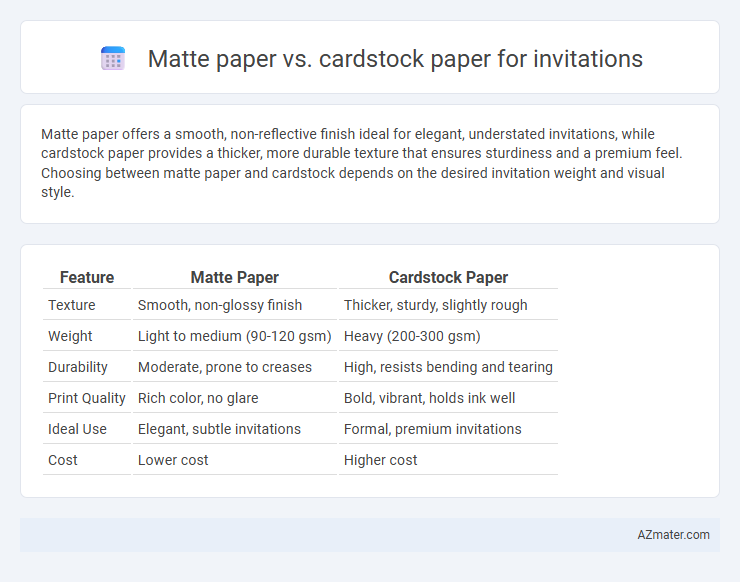Matte paper offers a smooth, non-reflective finish ideal for elegant, understated invitations, while cardstock paper provides a thicker, more durable texture that ensures sturdiness and a premium feel. Choosing between matte paper and cardstock depends on the desired invitation weight and visual style.
Table of Comparison
| Feature | Matte Paper | Cardstock Paper |
|---|---|---|
| Texture | Smooth, non-glossy finish | Thicker, sturdy, slightly rough |
| Weight | Light to medium (90-120 gsm) | Heavy (200-300 gsm) |
| Durability | Moderate, prone to creases | High, resists bending and tearing |
| Print Quality | Rich color, no glare | Bold, vibrant, holds ink well |
| Ideal Use | Elegant, subtle invitations | Formal, premium invitations |
| Cost | Lower cost | Higher cost |
Introduction to Invitation Paper Choices
Matte paper offers a smooth, non-glossy finish ideal for elegant and understated invitations, enhancing readability and color vibrancy without glare. Cardstock paper is thicker and more durable, providing a premium feel and sturdy structure perfect for formal events or invitations requiring durability. Choosing between matte paper and cardstock depends on the desired invitation texture, weight, and overall aesthetic impact.
What is Matte Paper?
Matte paper is a non-glossy, smooth-textured paper that provides a soft, muted finish ideal for elegant invitation designs. It absorbs ink well, reducing glare and enhancing readability, making printed text and images appear crisp and refined. Matte paper is often chosen for invitations requiring a sophisticated, understated look without the shine of glossy or coated surfaces.
What is Cardstock Paper?
Cardstock paper is a thick, durable type of paper commonly used for invitations due to its sturdy feel and professional appearance. Unlike matte paper, which has a smooth and non-glossy finish ideal for high-quality prints, cardstock offers greater rigidity, making it less prone to bending or damage. This heavyweight paper enhances the tactile experience of invitations, ensuring they appear elegant and maintain their shape during handling and mailing.
Key Differences Between Matte and Cardstock Paper
Matte paper features a smooth, non-glossy finish that enhances readability and provides a subtle, elegant look for invitations. Cardstock paper, known for its thickness and rigidity, offers superior durability and a premium feel, making it ideal for formal invitations that require a sturdy base. The key difference lies in texture and weight: matte paper emphasizes a flat, muted appearance, while cardstock guarantees structural integrity and a tactile sense of quality.
Pros and Cons of Matte Paper for Invitations
Matte paper for invitations offers a smooth, non-reflective surface that enhances readability and provides a sophisticated, understated look, making it ideal for formal events. Its ability to minimize glare and fingerprints ensures that the printed text and colors remain clear and vibrant over time; however, it can sometimes appear less vivid compared to glossy options and may show smudges more easily during handling. Matte paper's thick, sturdy texture is perfect for creating durable invitations but may not be as flexible or heavy as cardstock, potentially limiting design creativity for certain styles.
Pros and Cons of Cardstock Paper for Invitations
Cardstock paper offers exceptional durability and a premium feel, making invitations look elegant and sturdy, which enhances their overall presentation. However, cardstock is thicker and less flexible than matte paper, potentially complicating folding and mailing processes and increasing postage costs due to its weight. Its smooth, non-glossy surface absorbs ink well, providing crisp, vibrant print quality but may show fingerprints or smudges more easily than matte finishes.
Print Quality: Matte vs Cardstock
Matte paper offers a smooth, non-reflective finish that reduces glare and enhances color accuracy, making text and images appear crisp and elegant for invitations. Cardstock paper, known for its thicker and sturdier build, provides exceptional durability and a premium feel, ensuring that printed colors remain vibrant and sharp without absorption issues. When choosing between matte and cardstock for invitations, consider that matte paper excels in minimizing shine for readability, while cardstock guarantees structural integrity and rich print quality.
Durability and Feel Comparison
Matte paper offers a smooth, non-reflective surface with a soft feel, providing a sophisticated look but less rigidity compared to cardstock. Cardstock paper is thicker and more durable, making invitations sturdier and more resistant to wear and tear while offering a tactile, heavyweight feel. The choice between matte paper and cardstock hinges on prioritizing a sleek, elegant finish versus enhanced durability and a substantial hand feel.
Cost Comparison: Matte Paper vs Cardstock
Matte paper generally costs less than cardstock due to its lighter weight and thinner composition, making it a budget-friendly choice for invitations. Cardstock, being thicker and more durable, typically commands a higher price but offers a premium feel and sturdiness. For invitations, choosing matte paper reduces overall printing expenses, while cardstock provides enhanced durability at an increased cost.
How to Choose the Best Paper for Your Invitations
Choosing the best paper for your invitations depends on the desired texture, durability, and printing quality, with matte paper offering a smooth, non-glossy finish ideal for vibrant ink absorption and easy readability. Cardstock paper provides a thicker, sturdier feel that conveys elegance and ensures the invitation withstands handling and mailing. Consider the event's formality and design elements; matte suits modern, minimalist styles, while cardstock enhances classic, luxurious invitations.

Infographic: Matte paper vs Cardstock paper for Invitation
 azmater.com
azmater.com